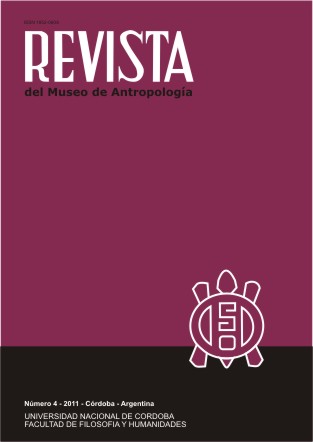Contributions of archeology to the construction of discourses about the local past from school. The case of the Pucara de Tilcara, Jujuy, Argentina
DOI:
https://doi.org/10.31048/1852.4826.v4.n1.5477Keywords:
Archaeology, educative-community, inter-culturality, local pastAbstract
This paper refers to some experiences of public archaeology done at Quebrada de Humahuaca’s educative institutions which help us to visibility archeology’s role in the construction of local past. Our objective was to observe appropriations and significations about of an archaeological local site in relation to socials’ dynamics of construction of heritage and identities, which have done in the farmer of Estate multiculturalism politics in this region.For this purpose, we generate multivocals’ spaces for re-construction of knowledges about the archaeological discipline and this contribution to the understanding of local past.
Downloads
References
Belli, E. y R. Slavutsky 2005 Discursos patrimonialistas. Consecuencias prácticas. Belli, E. y R. Slavutsky (Eds), Patrimonio en el Noroeste Argentino: Otras
historias, pp. 39-64. Instituto Interdisciplinario Tilcara, Universidad de Buenos Aires.
Casanova, E. 1968. El Pucará de Tilcara. (Antecedentes, Reconstrucción, Guía). Publicación No.1. Facultad de Filosofía y Letras, Museo del Pucará de Tilcara, Universidad de Buenos Aires.
García Canclini, N. 2001. Culturas Híbridas. Estrategias para entrar y salir de la modernidad. Paidos, Buenos Aires.
García Canclini, N. 2006. Diferentes, Desiguales y Desconectados. Mapas de la interculturalidad. Gedisa Editorial, Barcelona.
Gnecco, C. 2002. La indigenización de las arqueologías nacionales. Convergencia Año 9, Nº 27: 133-149, Universidad Autónoma del Estado de México, Toluca, México http://redalyc.uaemex.mx (02/08/2010).
Guber, R. 2004. El salvaje metropolitano. Reconstrucción del conocimiento social en el trabajo de campo. Paidos, Buenos Aires.
Hodder, I. 2008. Multivocality and Social Archaeology. Habu, J.; C. Fawcett y J. Matsunaga (Ed), Evaluating Multiple Narratives: Beyond Nationalist, Colonialist, Imperialist Archaeologies, 196-200. Springer, Berkeley.
Kojan, D. 2008. Paths of Power and Politics: Historical Narratives at the Bolivian Site of Tiwanaku. Habu, C. Fawcett and J.M. Matsunaga (eds), Evaluating Multiple Narratives. Beyond Nationalist, Colonialist, Imperialist Archaeologies. J. pp. 69-85, Springer.
Layton, R. 1989. Introduction: conflict in the Archaeology of living traditions. Layton, R. (Ed), Conflict in the Archaeology of the Living Traditions, Routledge, London & New York.
Merriman, N. 2004. Involving the public in museum archaeology. Merriman, N. (Ed.), Public Archaeology, pp. 85-108. Routledge, London y New York.
Montenegro, M. 2010. Patrimonio arqueológico en el sector septentrional del Noroeste Argentino. Propuestas pedagógicas para su preservación. Tesis para optar al título de Doctor en Antropología. Universidad Católica del Norte y Universidad de Tarapacá, Chile.
Montenegro, M. 2009. El patrimonio arqueológico de Jujuy: miradas diversas desde la escuela. Estudios Sociales del NOA, nueva serie 10: 107-121.
Montenegro, M. y M. E. Aparicio. 2008. Los niños y el patrimonio ¿Una deuda de la Educación? Cuadernos 34: 103-119.
Montenegro, M. y M. E. Aparicio. 2010. Festividades, celebraciones y patrimonio en Jujuy: experiencias desde la escuela. Rubinelli, M. L. (Comp.) ¿Los otros como nosotros? Interculturalidad y Ciudadanía en la Escuela. Reflexiones desde América Latina, Tomo II: 61-72. Unidad de Pensamiento Latinoamericano, relaciones interétnicas e interculturales, Universidad Nacional de Jujuy.
Montenegro, M. y M.C. Rivolta. 2010. Re-construyendo el presente desde el pasado: los arqueólogos y sus desafíos. Ponencia presentada al Simposio “Arqueología y Desarrollo”, V Encuentro de Teoría Arqueológica de América del Sur. Universidad Central de Venezuela, Caracas.
Otero, C. 2009. Cien años de investigaciones. El Pucará de Tilcara cuenta su historia, Conferencia en el marco del II Taller Internacional de Arqueología del NOA y Andes Centro Sur, Facultad de Humanidades y Ciencias Sociales, Universidad Nacional de Jujuy.
Otero, C. 2010. La Arqueología en el relato oficial del Estado Nacional. Una mirada desde el Pucará de Tilcara (Jujuy, Argentina). Revista Arqueología Suramericana. Universidad del Cauca, Universidad Nacional de Catamarca y World Archaeological Congress. En prensa.
Prats, LL. 1997. Antropología y Patrimonio. Ariel, Barcelona.
Rosas Mantecón, A. 1999. Las jerarquías simbólicas del patrimonio: distinción social e identidad barrial en el Centro Histórico de la Ciudad de México. http://www.naya.org.ar/patrimonio (10/07/2008)
Rubinelli, M. L. 2010. Algunas cuestiones acerca de una educación intercultural. Rubinelli, M. L. (Comp.) ¿Los otros como nosotros? Interculturalidad y Ciudadanía en la Escuela. Reflexiones desde América Latina, Tomo II: 37-48. Unidad de Pensamiento Latinoamericano, relaciones interétnicas e interculturales, Universidad Nacional de Jujuy.
Schadla-Hall, T. 2004. The comforts of unreason: the importance and relevance of alternative archaeology. Merriman, N. (Ed.) Public Archaeology, pp. 255-271. Routledge, London y New York.
Spravkin, L. 1997. Educación plástica en la escuela. Un lenguaje en acción. Ediciones Novedades educativas, Buenos Aires.
Trigger, B. 1996. Alternative Archaeologies: Nationalist, Colonialist, Imperialist. Preucel, R. e I. Hodder (Eds.) Contemporary Archaeology in Theory, pp. 615-631.
Blackwell Publishers, Oxford, UK. Ucko, P. 1989. Foreword. Layton, R. (Ed) Conflict in the Archaeology of the Living Traditions. Routledge, London & New York.
Walsh, C. Interculturalidad crítica y pedagogía decolonial: in-surgir, re-existir y re-vivir. Medina Melgarejo (Comp.) Educación intercultural en América Latina. Memorias, horizontes históricos y disyuntivas políticas. Universidad Pedagógica Nacional, Plaza Valdez Editores, México.
Unidos para prevenir saqueos arqueológicos. Diario Pregón, San Salvador de Jujuy, Argentina, Año XIII, N° 5542, Sección Interior – Tilcara. http://www.pregon.com.ar/vernoticia.asp?id=95835
Downloads
Published
Issue
Section
License
Those authors who have publications with this Journalaccept the following terms:
a. Authors will retain their copyrights and guarantee the journal the right of first publication of their work, which will be simultaneously subject to the Creative Commons Attribution License (Licencia de reconocimiento de Creative Commons) that allows third parties to share the work as long as its author and his first publication in this journal.
b. Authors may adopt other non-exclusive licensing agreements for the distribution of the version of the published work (eg, deposit it in an institutional electronic file or publish it in a monographic volume) provided that the initial publication in this journal is indicated.
c. Authors are allowed and recommended to disseminate their work on the Internet (eg in institutional telematic archives or on their website) before and during the submission process, which can lead to interesting exchanges and increase citations of the published work. (See The Effect of Open Access - El efecto del acceso abierto)












